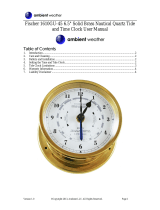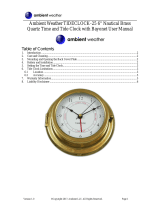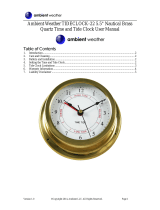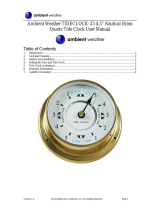
INC.
30 Samuel Barnet Boulevard
New Bedford, Massachusetts 02745
(508) 995-2200 www.maximum-inc.com
While this lunar cycle is the primary force behind the workings of the tide, it is not the only force. On a
daily basis the average tidal cycle of 24 hours and 50 minutes can be affected by such cosmic variables
as the relative position of the earth to the sun and the specific elliptical pattern of the moon around the
earth. Localized variables affecting daily tides also exist. These would include strong winds, changes in
atmospheric pressure, distant storms and an infinite number of other atmospheric conditions. The total
affect of all these different factors cause tides to vary around the average point of 24 hours and 50
minutes. These variations can cause the reading of your tide clock to be either fast or slow in relation to
actual tides, by as much as one hour or more on any given day. However, the rhythmic 24 hour and 50
minute cycle will prevail over any given 28 day lunar period. Basically what all this means, is that on any
give day the clock may read fast or slow, but over a 28-day period it will average itself out to be correct.
For most purposes, high and/or low tide is not really a point in time, but a condition that exists over a
period of time. If for some reason you require exact tide information you should always refer to a current
tide table. The purpose of a tide clock is not to be exact, but to tell us the best approximate time to go
swimming, fishing, boating, etc. For these functions a tide clock works just fine.
TROUBLESHOOTING
It is very easy to determine if your Harbormaster is functioning properly. First make sure it has a fresh
battery. Then, simply time it against a regular clock. It takes 12 hours for a regular clock to make one
complete revolution. However, a tide clock requires 12 hours and 25 minutes to make one complete
revolution. If the hand on your Harbormaster completes one revolution in 12 hours and 25 minutes it is
working properly. If it takes more or less than 12 hours and 25 minutes then there is a problem and the
clock should be sent to the factory for service.
IMPORTANT ADDITIONAL INFORMATION
Your brass case is solid brass A70-30 Hollowware quality with a durable lacquer finish. It is in fact a
piece of jewelry and should be treated as such. It should be cleaned at least once a week to keep
airborne pollutants (dust, etc…) and any moisture from collecting on the case thereby attacking the
lacquer. At no time should you use an abrasive cleaner or cloth on the brass case. Simply use a soft
cloth or soft paper towel with a mild glass cleaner to wipe the case clean. If your instruments are in a
summer home, and you are not able to clean them regularly, simply lay a small cloth or towel across the
top two-thirds so that dust cannot settle on the finish.
COMPONENTS
Along with the indicator, the following components are included with the instrument:









